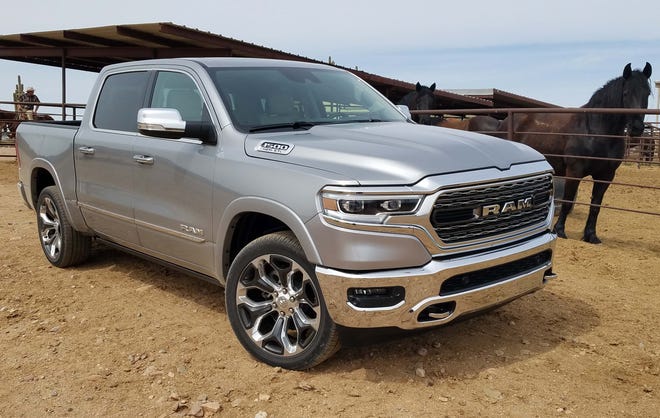The gas engine is dead, long live the gas engine.
In a nod to the uncertain road ahead for electric-vehicle adoption, Stellantis announced an all-new internal-combustion engine line Friday, even as the automaker targets 50% EV sales in the U.S. by 2030. Called Hurricane, the high-performance, 3.0-liter, twin-turbo, inline-6 cylinder will replace V-8 powerplants for the company’s rear-wheel-drive-based platforms on which the profitable Ram pickup, Jeep SUVs and Dodge sedan lines are based.

Governments are pushing automakers toward battery-powered drivetrains, but consumer adoption has struggled at 3% market share due to issues with range, charging infrastructure and affordability. The Hurricane drivetrain ensures Stellantis will be able to meet draconian EPA emissions rules beginning in 2026 while testing the market with new EVs and satisfying customer demand for high-horsepower truck and car gas engines.
“Internal combustion engines still matter,” said Stellantis propulsion system chief Micky Bly in introducing the Hurricane. “There are not a lot of people talking about new ICE engines these days, but we have a need.”
That need focuses on the automaker’s crown jewels: Ram and Jeep as well as its iconic Dodge performance brand. Their signature models are RWD truck and truck-based SUV applications (Ram pickup, Jeep Grand Wagoneer, Jeep Grand Wagoneer) and large unibody SUVs and sedans (Jeep Grand Cherokee, Dodge Challenger, Dodge Charger, Dodge Durango). They boast high-performance V-8 engines with popular trims like TRX, SRT and Scat Pack — as well as standard models powered by the workhorse, normally-aspirated Pentastar V-6.

The V-8s, however, are in the crosshairs of EPA carbon-dioxide rules that are due to ramp up in 2026 and punish gas-guzzlers.
Hurricane is an old family name dating back to 1950s Willys inline-4 cylinder performance engines found in Jeepsters and stations wagons. The new, forced-induction, aluminum-block engine follows in those footsteps with inherently smooth, inline-6 architecture that, Bly said, will produce class-leading performance. A Standard Output version is capable of more than 400 horsepower and 450 pound-feet of torque, while a High Output six is optimized for performance and will be capable of more than 500 horsepower and 475 pound-feet of torque.
Those are performance numbers to rival a twin-turbo BMW M3 inline-6. The SO and HO feature class-leading 133 and 166 horsepower per liter, respectively, while reducing CO2 emissions by about 15%.
“Internal combustion engines will play a key role in our portfolio for years to come,” said Bly. “Hurricane is a no-compromise engine that delivers an important reduction in greenhouse gases without asking our customers to give up performance.”
The move away from V-8s was telegraphed by former Fiat Chrysler CEO Mike Manley, who told The Detroit News at the 2019 Detroit Auto Show: “The reality is those platforms and that technology we used does need to move on. They can’t exist as you get into the middle-2020s.”
The Hurricane promises more grunt than the 5.7-liter and 6.4-liter V-8s it will replace, but it will not use the signature “Hemi” cylinder construction that has been synonymous with Jeep-Ram-Dodge performance marketing.
Instead, Plasma Transfer Wire Arc — popularly known as “spray bore” — cylinder technology is the new buzzword for the I-6’s impressive numbers. The technology was pioneered by Ford in high-output Mustang GT350 and GT500 V-8 engines.

The Stellantis strategy echoes that of Ford’s 2.7-liter/3.0-liter, twin-turbo Ecoboost V-6 engines that debuted in 2015, as well as Toyota, which just replaced the Tundra pickup’s V-8 with a twin-turbo V-6. Ford’s twin-turbos now anchor the F-150 pickup lineup — replacing V8s while providing more power and efficiency.
“Ford has already been down this road,” said Autoweek Executive Editor Tom Murphy, who led Ward’s respected 10 Best Engines awards for years. “The Ecoboost V-6 has taken over the vast majority of F-150 sales. They’ve proved you don’t need a V-8.”
Still, Ford customers have bellyached about the lack of visceral V-8 appeal in the F-150 Raptor, and the brand is expected to put a V-8 into the forthcoming Raptor R.
While V-8s may still play a role in Stellantis’s future, Dodge is expected to focus on electrified muscle in the near future, beginning with a replacement for the outgoing, supercharged 6.2-liter Hellcat V-8.
“I think that electrification will certainly be part of the formula that says what is American muscle in the future,” Manley said back in 2019. “What it isn’t going to be is a V-8, supercharged, 700-horsepower engine.”
Autoweek’s Murphy speculates the Hurricane’s rear-drive application could open up the front axle for an electric motor to make electrified, plug-in versions of future Stellantis models. Stellantis says the Hurricane will also be the primary internal combustion powerplant using future, electrified STLA Large and STLA Frame platforms.

In addition to its Ram workhorses, Jeep and Dodge have stuffed V-8s under the hood of everything from the Wrangler 392 to the Dodge Durango Hellcat. Look for Hurricane variants — including with electrification — to replace them.
Expect brand announcements in the coming months detailing Hurricane applications, with the engines focused on the North American market with its high truck sales and lower-cost fuel and regulation. Hurricane makes less sense in overseas markets like Europe where Stellantis expects to be 100% electric by 2030 in a brutal regulatory environment. Expect the workhorse Pentastar V-6 and turbocharged, 2.0-liter I-4 (a close relative of the Hurricane) to anchor Wrangler and Cherokee models stateside.
“I wonder about Ram pickup trucks going electric” in North America, Murphy said. “Towing with an EV can be disappointing, especially if you’re towing 7,000-10,000 pounds. Ram is going to need gas engines to manage the migration to electrification.”

Stellantis’s Bly said that the Hurricane engines are capable of hybridization. The I-6 is already under production in Saltillo, Mexico, alongside the Hemi V-8 line. The Hurricane models are not just more fuel efficient; they are more efficient to assemble with the SO and HO engines sharing most parts. HO versions benefit from bigger intercoolers and turbochargers.
Henry Payne is auto critic for The Detroit News. Find him at hpayne@detroitnews.com or Twitter @HenryEPayne.